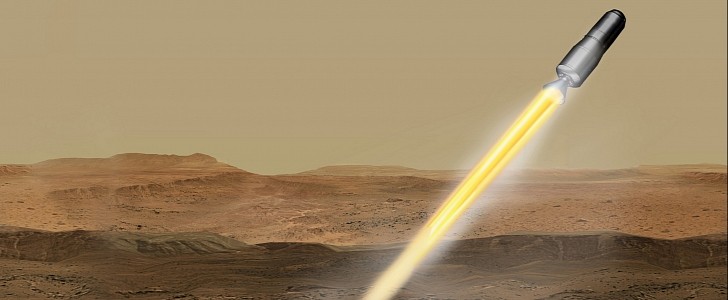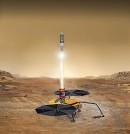NASA has awarded Lockheed Martin a $194 million contract to develop the Mars Ascent Vehicle (MAV) – a rocket designed will carry the first "rock, sediment, and atmospheric samples" from Mars to our home. The MAV is will be part of a multi-mission campaign and is set to return pieces of the Red Planet in the 2030s.
NASA's Perseverance rover has been busy drilling into Mars' rocks for the past few months, overcoming any challenges the harsh environment throws at it. The Mars Sample Return mission aims to bring pieces of the alien world stored by the rover in its belly back to Earth. Here, scientists could study them using advanced lab equipment, which would be too big to carry the Red Planet.
It will take nearly a decade to get the samples into terrestrial labs, and for that to happen, the mission requires an effort from multiple European partners and NASA centers. The MAV will play a crucial role in the campaign as it is set to become the first rocket that will blast off from another planet's surface.
According to NASA, the rocket will work together with the agency's Sample Retrieval Lander, the European Space Agency (ESA) Sample Fetch Rover, and the Earth Return Orbiter to return the samples back to Earth.
The lander is scheduled to take off in 2026 from the Kennedy Space Center in Florida together with the MAV and a small ESA machine called the Sample Fetch Rover. Once it touches down near or in the Jezero Crater on Mars, the rover would retrieve the samples left behind by Perseverance.
The samples would then be returned to the lander and loaded inside a sample container located in the MAV. The lander will function as the rocket's launch platform. Once in Mars orbit, MAV would meet with the orbiter, which will catch the container and then head to Earth.
The samples are expected to reach Earth in the 2030s. It's a complex mission, and Lockheed Martin must make sure that the MAV can overcome any challenge. First, the rocket will have to be small enough to fit inside the lander. Then, the team has to ensure that the vehicle is capable of withstanding the harsh environment on Mars and that it is able to work with other spacecraft.
This will be the first mission to return samples from another world, and it will include the first launch from another planet's surface. The pieces gathered by Perseverance could reveal important clues about Mars' past, showing if there was once life on our neighbor.
It will take nearly a decade to get the samples into terrestrial labs, and for that to happen, the mission requires an effort from multiple European partners and NASA centers. The MAV will play a crucial role in the campaign as it is set to become the first rocket that will blast off from another planet's surface.
According to NASA, the rocket will work together with the agency's Sample Retrieval Lander, the European Space Agency (ESA) Sample Fetch Rover, and the Earth Return Orbiter to return the samples back to Earth.
The lander is scheduled to take off in 2026 from the Kennedy Space Center in Florida together with the MAV and a small ESA machine called the Sample Fetch Rover. Once it touches down near or in the Jezero Crater on Mars, the rover would retrieve the samples left behind by Perseverance.
The samples would then be returned to the lander and loaded inside a sample container located in the MAV. The lander will function as the rocket's launch platform. Once in Mars orbit, MAV would meet with the orbiter, which will catch the container and then head to Earth.
The samples are expected to reach Earth in the 2030s. It's a complex mission, and Lockheed Martin must make sure that the MAV can overcome any challenge. First, the rocket will have to be small enough to fit inside the lander. Then, the team has to ensure that the vehicle is capable of withstanding the harsh environment on Mars and that it is able to work with other spacecraft.
This will be the first mission to return samples from another world, and it will include the first launch from another planet's surface. The pieces gathered by Perseverance could reveal important clues about Mars' past, showing if there was once life on our neighbor.
NASA’s first rocket launch from another planet is now one step closer. @LockheedMartin has been tapped to build the Mars Ascent Vehicle (MAV), part of a multi-mission campaign to return samples of the Red Planet to Earth. https://t.co/SDGWHjZNzX pic.twitter.com/vEQvHzBIwE
— NASA Mars (@NASAMars) February 7, 2022







